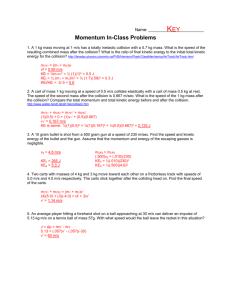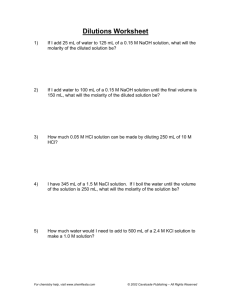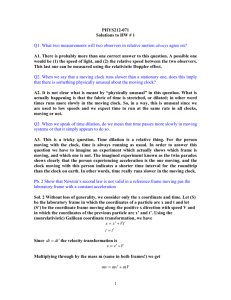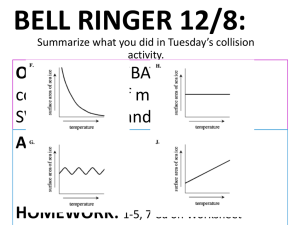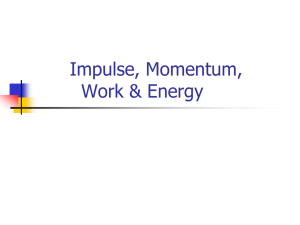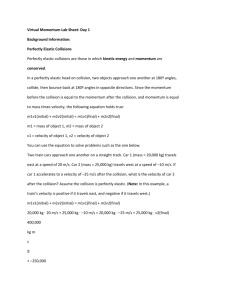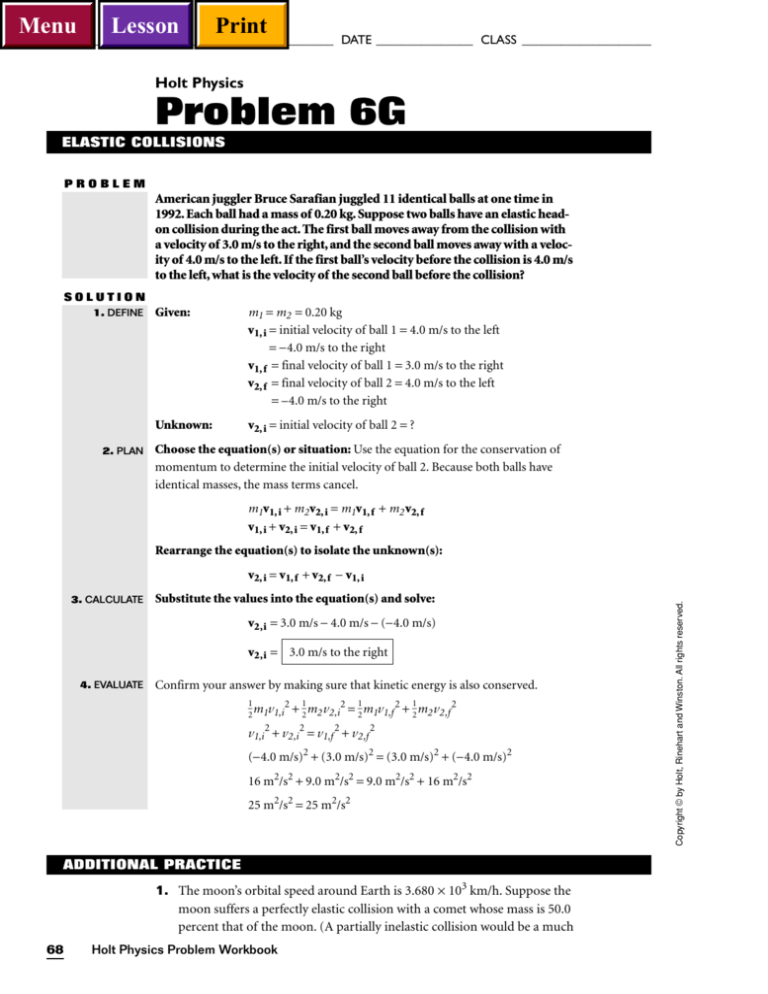
Menu
Lesson
Print
NAME ______________________________________
DATE _______________ CLASS ____________________
Holt Physics
Problem 6G
ELASTIC COLLISIONS
PROBLEM
American juggler Bruce Sarafian juggled 11 identical balls at one time in
1992. Each ball had a mass of 0.20 kg. Suppose two balls have an elastic headon collision during the act. The first ball moves away from the collision with
a velocity of 3.0 m/s to the right, and the second ball moves away with a velocity of 4.0 m/s to the left. If the first ball’s velocity before the collision is 4.0 m/s
to the left, what is the velocity of the second ball before the collision?
SOLUTION
1. DEFINE
2. PLAN
Given:
m1 = m2 = 0.20 kg
v1, i = initial velocity of ball 1 = 4.0 m/s to the left
= −4.0 m/s to the right
v1, f = final velocity of ball 1 = 3.0 m/s to the right
v2, f = final velocity of ball 2 = 4.0 m/s to the left
= –4.0 m/s to the right
Unknown:
v2, i = initial velocity of ball 2 = ?
Choose the equation(s) or situation: Use the equation for the conservation of
momentum to determine the initial velocity of ball 2. Because both balls have
identical masses, the mass terms cancel.
m1v1, i + m2 v2, i = m1v1, f + m2 v2, f
v1, i + v2, i = v1, f + v2, f
Rearrange the equation(s) to isolate the unknown(s):
3. CALCULATE
Substitute the values into the equation(s) and solve:
v2,i = 3.0 m/s − 4.0 m/s − (−4.0 m/s)
v2,i = 3.0 m/s to the right
4. EVALUATE
Confirm your answer by making sure that kinetic energy is also conserved.
1
1
1
1
m v 2 + m v 2 = m v 2 + m v 2
2 1 1,i
2 2 2,i
2 1 1,f
2 2 2,f
v1,i 2 + v2,i 2 = v1,f 2 + v2,f 2
(−4.0 m/s)2 + (3.0 m/s)2 = (3.0 m/s)2 + (−4.0 m/s)2
16 m2/s2 + 9.0 m2/s2 = 9.0 m2/s2 + 16 m2/s2
25 m2/s2 = 25 m2/s2
ADDITIONAL PRACTICE
1. The moon’s orbital speed around Earth is 3.680 × 103 km/h. Suppose the
moon suffers a perfectly elastic collision with a comet whose mass is 50.0
percent that of the moon. (A partially inelastic collision would be a much
68
Holt Physics Problem Workbook
Copyright © by Holt, Rinehart and Winston. All rights reserved.
v2, i = v1, f + v2, f − v1, i
Menu
Lesson
Print
NAME ______________________________________ DATE _______________ CLASS ____________________
more realistic event.) After the collision, the moon moves with a speed of
–4.40 × 102 km/h, while the comet moves away from the moon at 5.740
× 103 km/h. What is the comet’s speed before the collision?
2. The largest beet root on record had a mass of 18.40 kg. The largest cabbage on record had a mass of 56.20 kg. Imagine these two vegetables
traveling in opposite directions. The cabbage, which travels 5.000 m/s to
the left, collides with the beet root. After the collision, the cabbage has a
velocity of 6.600 × 10–2 m/s to the left, and the beet root has a velocity of
10.07 m/s to the left. What is the beet root’s velocity before the perfectly
elastic collision?
3. The first astronaut to walk in outer space without being tethered to a
spaceship was Capt. Bruce McCandless. In 1984, he used a jet backpack,
which cost about $15 million to design, to move freely about the exterior
of the space shuttle Challenger. Imagine two astronauts working in outer
space. Suppose they have equal masses and accidentally run into each
other. The first astronaut moves 5.0 m/s to the right before the collision
and 2.0 m/s to the left afterwards. If the second astronaut moves 5.0 m/s
to the right after the perfectly elastic collision, what was the second astronaut’s initial velocity?
Copyright © by Holt, Rinehart and Winston. All rights reserved.
4. Speeds as high as 273 km/h have been recorded for golf balls. Suppose a
golf ball whose mass is 45.0 g is moving to the right at 273 km/h and
strikes another ball that is at rest. If after the perfectly elastic collision the
golf ball moves 91 km/h to the left and the other ball moves 182 km/h to
the right, what is the mass of the second ball?
5. Jana Novotna of what is now the Czech Republic has the strongest serve
among her fellow tennis players. In 1993, she sent the ball flying with a
speed of 185 km/h. Suppose a tennis ball moving to the right at this speed
hits a moveable target of unknown mass. After the one-dimensional, perfectly elastic collision, the tennis ball bounces to the left with a speed of
80.0 km/h. If the tennis ball’s mass is 5.70 × 10–2 kg, what is the target’s
mass? (Hint: Use the conservation of kinetic energy to solve for the second unknown quantity.)
6. Recall the two colliding snow trains in item 6 of the previous section.
Suppose now that the collision between the two trains is perfectly elastic
instead of inelastic. The train with a 4.00 × 105 kg and a velocity of
32.0 km/h to the right is struck from behind by a second train with a
mass of 1.60 × 105 kg and a velocity of 36.0 km/h to the right. If the first
train’s velocity increases to 35.5 km/h to the right, what is the final velocity of the second train after the collision?
7. A dump truck used in Canada has a mass of 5.50 × 105 kg when loaded
and 2.30 × 105 kg when empty. Suppose two such trucks, one loaded and
one empty, crash into each other at a monster truck show. The trucks are
supplied with special bumpers that make a collision almost perfectly
elastic. If the trucks hit each other at equal speeds of 5.00 m/s and the
less massive truck recoils to the right with a speed of 9.10 m/s, what is the
velocity of the full truck after the collision?
Problem 6G
69
Menu
Lesson
Print
Additional Practice 6G
Givens
Solutions
1. m2 = 0.500 m1
Momentum conservation
3
v1, i = 3.680 × 10 km/h
2
v1, f = −4.40 × 10 km/h
v2, f = 5.740 × 103 km/h
m1v1, i + m2v2, i = m1v1, f + m2v2, f
m1v1, f + m2v2, f − m1v1, i m1v1, f + (0.500)m1v2, f − m1v1, i
v2, i =
=
(0.500)m1
m2
v2, i = (2.00)v1, f + v2, f − (2.00)v1, i = (2.00)(−4.40 × 102 km/h) + 5.740 × 103 km/h
− (2.00)(3.680 × 103 km/h) = −8.80 × 102 km/h + 5.740 × 103 km/h
− 7.36 × 103 km/h
v2, i = −2.50 × 103 km/h
Conservation of kinetic energy (check)
1
m v 2
2 1 1, i
+ 2m2v2, i2 = 2m1v1, f 2 + 2m2v2, f 2
1
1
1
m v 2
2 1 1, i
+ 2(0.500)m1v2, i2 = 2m1v1, f 2 + 2(0.500)m1v2, f 2
1
1
1
1
v1, i2 + (0.500)v2, i2 = v1, f 2 + (0.500)v2, f 2
(3.680 × 103 km/h)2 + (0.500)(−2.50 × 103 km/h)2 = (−4.40 × 102 km/h)2 + (0.500)
(5.740 × 103 km/h)2
1.354 × 107 km2/h2 + 3.12 × 106 km2/h2 = 1.94 × 105 km2/h2 + 1.647 × 107 km2/h2
7
2
2
7
2
II
2
1.666 × 10 km /h = 1.666 × 10 km /h
2. m1 = 18.40 kg
m2 = 56.20 kg
v2, i = 5.000 m/s to the left
= −5.000 m/s
v2, f = 6.600 × 10−2 m/s to
the left
= − 6.600 × 10−2 m/s
Copyright © by Holt, Rinehart and Winston. All rights reserved.
v1, f = 10.07 m/s to the left
= −10.07 m/s
Momentum conservation
m1v1, i + m2v2, i = m1v1, f + m2v2, f
m1v1, f + m2v2, f − m2v2, i
v1, i =
m1
(18.40 kg)(−10.07 m/s) + (56.20 kg)(−6.600 × 10−2 m/s) − (56.20 kg)(−5.000 m/s)
v1, i =
18.40 kg
−185.3 kg•m/s − 3.709 kg•m/s + 281.0 kg•m/s 92.0 kg•m/s
v1, i = = = 5.00 m/s
18.40 kg
18.40 kg
v1, i = 5.00 m/s to the right
Conservation of kinetic energy (check)
1
m v 2
2 1 1, i
1
1
1
+ 2m2v2, i2 = 2m1v1, f 2 + 2m2v2, f 2
1
1
(18.40 kg)(5.00 m/s)2 + (56.20)(−5.000
2
2
1
+ 2(56.20 kg)(−6.600 × 10−2 m/s)2
1
m/s)2 = 2(18.40 kg)(−10.07 ms)2
2.30 × 102 J + 702.5 J = 932.9 J + 0.1224 J
932 J = 933 J
The slight difference arises from rounding.
Section Two—Problem Workbook Solutions
II Ch. 6–11
Menu
Lesson
Print
Givens
Solutions
3. m1 = m2
v1, i = 5.0 m/s to the right
= +5.0 m/s
v1, f = 2.0 m/s to the left
= −2.0 m/s
v2, f = 5.0 m/s to the right
= +5.0 m/s
Momentum conservation
m1v1, i + m2v2, i = m1v1, f + m2v2, f
m1v1, f + m2v2, f − m1v1, i
v2, i =
= v1, f + v2, f − v1, i
m2
v2, i = −2.0 m/s + 5.0 m/s − 5.0 m/s = −2.0 m/s
v2, i = 2.0 m/s to the left
Conservation of kinetic energy (check)
1
m v 2
2 i 1, i
1
1
1
+ 2m2v2, i2 = 2m1v1, f 2 + 2m2v2, f 2
v1,i2 + v2,i2 = v1, f 2 + v2, f 2
(5.0 m/s)2 + (−2.0 m/s)2 = (−2.0 m/s)2 + (5.0 m/s)2
25 m2/s2 + 4.0 m2/s2 = 4.0 m2/s2 + 25 m2/s2
29 m2/s2 = 29 m2/s2
4. m1 = 45.0 g
II
v1, i = 273 km/h to the right
= +273 km/h
v2, i = 0 km/h
v1, f = 91 km/h to the left
= −91 km/h
v2, f = 182 km/h to the right
= +182 km/h
Momentum conservation
m1v1, i + m2v2, i = m1v1, f + m2v2, f
m1v1, f − m1v1, i (45.0 g)(−91 km/h) − (45.0 g)(273 km/h)
=
m2 =
v2, i − v2, f
0 km/h − 182 km/h
−4.1 103 g •km/h − 12.3 103 g •km/h −16.4 103 g •km/h
m2 = =
−182 km/h
−182 km/h
m2 = 90.1 g
Conservation of kinetic energy (check)
1
m v 2
2 1 1,i
1
1
1
+ 2m2 v2,i2 = 2m1v1, f 2 + 2m2 v2, f
1
1
(45.0 g)(273 103 m/h)2(1 h/3600 s)2 + (90.1 g)(0 m/s)2
2
2
1
1
= 2(45.0 g)(−91 × 103 m/h)2(1 h/3600 s)2 + 2(90.1 g)(182 × 103
m/h)2 (1 h/3600 s)2
129 J + 0 J = 14 J + 115 J
5. v1,i = 185 km/h to the right
185 km/h
v2,i = 0 km/h
vi,f = 80.0 km/h to the left
= −80.0 km/h
m1 = 5.70 10–2 kg
Momentum conservation
m1v1, i + m2v2,i = m1v1,f + m2v2,f
m v − mv = v –v
m
m [185 km/h − (−80.0 km/h)] = v
m
v = (265 km/h) to the right
m m1
m1
1,i
2
1,f
2,f
2,i
2
1
2,f
− 0 km/h
2
1
2,f
2
Conservation of kinetic energy
1
1
1
KEi = 2m1v1,i2 + 2m2 v2,i2 = 2m1v1,i2
1
1
KEf = 2m1v1, f 2 + 2m2v2,f 2
1
m v 2
2 1 1,i
1
1
= 2m1v1,f 2 + 2m2 v2,f 2
m1
m
(v1,i)2 = 1 (v1,f)2 + v2,f 2
m2
m2
m
m
m (185 km/h) = m (−80.0 km/h) + v
1
2
II Ch. 6–12
Holt Physics Solution Manual
2
1
2
2
2
2,f
Copyright © by Holt, Rinehart and Winston. All rights reserved.
129 J = 129 J
Menu
Lesson
Print
Givens
Solutions
mm(3.42×10km/h)−mm(6.40×10km/h) = v
1
4
2
1
2
2
v2,f =
3
2
2
2,f
2
mm (2.78×10k m/h) = mm 167 km/h
1
4
2
2
2
1
2
Equating the two results for v2,f yields the ratio of m1 to m2.
m (265 km/h) = m (167 km/h)
m1
m1
2
2
265 km/h =
m2
(167 km/h)
m1
m2
265 km/h 2
= = 2.52
m1
167 km/h
m2 = (2.52) m1 (2.52)(5.70 10–2 kg)
m2 = 0.144 kg
6. m1 = 4.00 × 105 kg
II
Momentum conservation
m2 = 1.60 × 105 kg
m1v1, i + m2v2, i = m1v1, f + m2v2, f
v1, i = 32.0 km/h to the right
m1v1, i + m2v2, i − m1v1, f
v2, f =
m2
v2, i = 36.0 km/h to the right
v1, f = 35.5 km/h to the right
(4.00 × 105 kg)(32.0 km/h) + (1.60 × 105 kg)(36.0 km/h) − (4.00 × 105 kg)(35.5 km/h)
v2, f =
1.60 × 105 kg
1.28 × 107 kg•km/h + 5.76 × 106 kg•km/h − 1.42 × 107 kg•km/h
v2, f =
1.60 × 105 kg
6
4.4 × 10 kg•km/h
v2, f =
1.60 × 105 kg
Copyright © by Holt, Rinehart and Winston. All rights reserved.
v2, f = 28 km/h to the right
Conservation of kinetic energy (check)
1
m v 2
2 1 1, i
1
1
1
+ 2m2v2, i2 = 2m1v1, f 2 + 2m2 v2, f 2
1
(4.00
2
1
× 105 kg)(32.0 × 103 m/h)2(1 h/3600 s)2 + 2(1.60 × 105 kg)(36.0 × 103 m/h)2
1
1
(1 h/3600 s)2 = 2(4.00 × 105 kg)(35.5 × 103 m/h)2(1 h/3600 s)2 + 2(1.60 × 105 kg)
(28 103 m/h)2(1 h/3600 s)2
1.58 × 107 J + 8.00 × 106 J = 1.94 × 107 J + 4.8 × 106 J
2.38 × 107 J = 2.42 × 107 J
The slight difference arises from rounding.
Section Two—Problem Workbook Solutions
II Ch. 6–13
Menu
Lesson
Print
Givens
Solutions
7. m1 = 5.50 × 105 kg
Momentum conservation
m2 = 2.30 × 10 kg
m1v1,i + m2v2,i = m1v1,f + m2v2,f
v1, i = 5.00 m/s to the right
= +5.00 m/s
m1v1,i + m2v2,i − m2v2,f
v1,f =
m1
v2, i = 5.00 m/s to the left
= −5.00 m/s
(5.50 × 105 kg)(5.00 m/s) + (2.30 × 105 kg)(−5.00 m/s) − (9.10 m/s)
v1,f =
5.50 × 105 kg
5
v2, f = 9.10 m/s to the right
= +9.10 m/s
2.75 106 kg•m/s – 1.15 106 kg•m/s –2.09 × 106 kg•m/s
v1,f =
= −0.89 m/s right
5.50 × 105 kg
v1,f = 0.89 m/s left
Conservation of kinetic energy (check)
1
m v 2
2 1 1, i
1
1
1
+ 2m2 v2, i2 = 2 m1v1, f 2 + 2m2v2, f 2
1
(5.50
2
1
1
× 105 kg)(5.00 m/s)2 + 2(2.30 × 105 kg)(−5.00 m/s)2 = 2(5.50 × 105 kg)
1
(−0.89 m/s)2 + 2(2.30 × 105 kg)(9.10 × m/s)2
II
6.88 × 106 J + 2.88 × 106 J = 2.2 × 105 J + 9.52 × 106 J
9.76 × 106 J = 9.74 × 106 J
Copyright © by Holt, Rinehart and Winston. All rights reserved.
The slight difference arises from rounding.
II Ch. 6–14
Holt Physics Solution Manual

